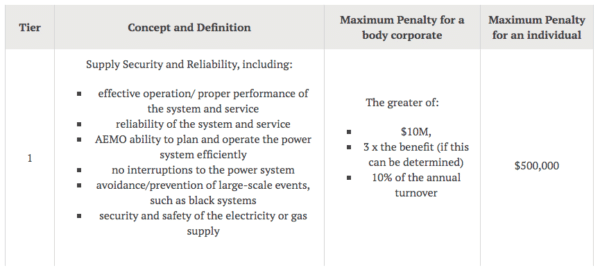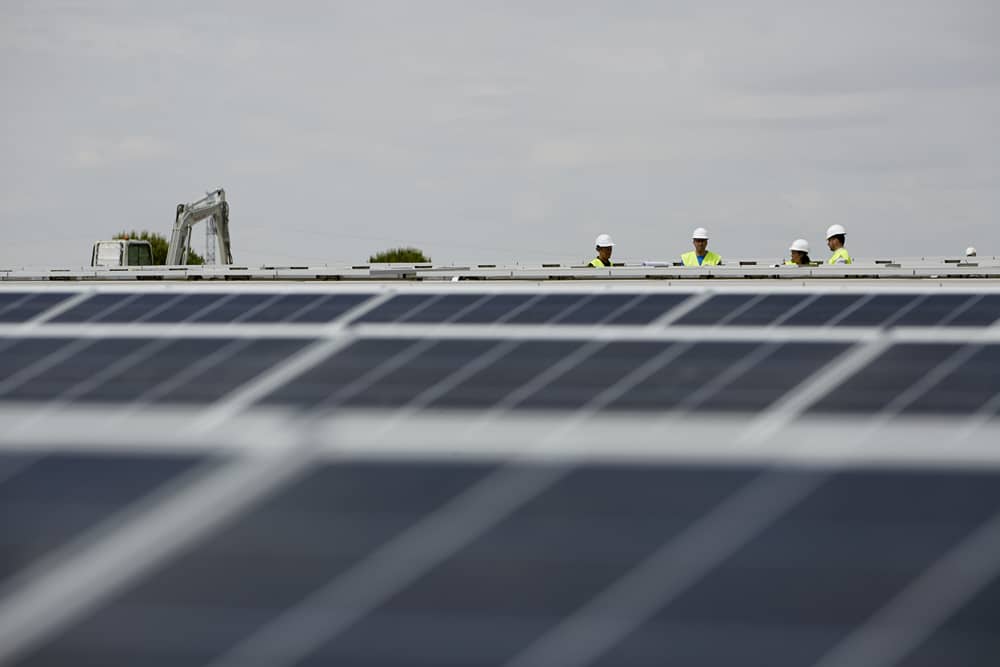From Watt Clarity
From January 29th this year the limits on the civil penalty that can apply to generators increased one hundredfold. The new regime has 3 tiers with the maximum for Tier 1 breaches now raised to $10M or more for large companies or $500,000 for an individual.

Why the Change?
There cannot be many industries where the maximum penalties for not following the operating rules increase so dramatically in one step. It seems an acknowledgment that the previous penalties were not sufficient a deterrent and one might surmise that some generators have not been taking the rules seriously enough to date. Indeed the AER says it expects the new penalty regime to:
“incentivise energy businesses to devote greater effort to comply with laws…”.
Tier 1 penalties cover four different concepts but one is highly relevant to a registered generator –where they breach a provision that is necessary to ensure ‘supply security and reliability’. This could include: ‘reliability of the system…AEMO ability to plan and operate the power system…no interruptions…avoidance/prevention of large-scale events, such as black systems and security of electricity supply’.
Note that these phrases relate not to the common woe that is the connection process – which will typically take 1-5 years, but about what happens after connection – which should last 15-25 years i.e. power system and trading operations.
The Rules
To know how this concept and these penalties affect generators, one can turn to the rules that govern them – the National Electricity Rules or NER. Helpfully, the clauses in the NER that attract these civil penalties are specifically annotated within the text.
Chapter 3 contains the Market Rules and has over 75 such references and Chapter 4 covers Power System Security – the very concept that Tier 1 ‘supply and security reliability’ points to. This makes it very easy to draw a clear line from any specific obligation in the NER to a potential and now very high civil penalty.
It’s not ‘O&M’
Before going further it’s worth highlighting that these functions are less about the operation and maintenance that a contractor might do with inverters or turbines. Whilst there is a link, these rules are more about the effect of that work at an asset level and how that affects the NEM. You might say this is more about the NEM side of the substation rather than the farm side.
Key operational obligations in the NER
Whilst there are many important NER obligations that come with penalties, key real-time clauses that seem to fall squarely into this $10m Tier 1 penalty category include:
- The need to follow dispatch instructions, and
- ensuring that appropriate personnel are available at all times to receive and immediately act upon dispatch instructions[1]
Following Dispatch Instructions
The need to follow dispatch instructions gets more than one mention[2] and it should be easy to understand why breaches of this obligation attract a civil penalty. A dispatch instruction is AEMO telling a generator – every five minutes, what output it should produce after taking into account the generators financial offer, its forecast production and a variety of demand and system strength factors.
The output of all generators must therefore be reasonably predictable for AEMO to keep the power system in balance so any ‘rogue’ generator that is not following its forecast or its instruction – for whatever reason – clearly becomes a risk to supply security and reliability for everyone.
These types of failures also create the public AEMO non-conformance notices that watchers of the NEM may see from time to time. The rule change of 11 March this year for semi-scheduled generator dispatch obligations was also about the need for predictable output – to quote the AER again, it intended to stop ‘semi scheduled generators turning off without instruction from the market operator.’
So, irrespective of whether previous deviations were deliberate or by accident, the need to follow dispatch instructions just got more important!
24×7 contact and plant control
Whilst following dispatch instructions will be an automated function for well-designed and maintained equipment, participants must still be contactable 24×7 by AEMO. All registered participants declared they met this requirement in their registration submission but as people and arrangements change, these new civil penalties make it even more important to keep those personnel details up to date.
Participants should also remember that the people nominated must be skilled and equipped to understand and comply with whatever instruction or query AEMO might have. The AEMO Registration Guide further states that “only Australian phone numbers are acceptable and all personnel must be based in Australia”. Clearly access to plant control hardware and regular training on Australian energy market rules needs to be part of making this happen successfully. As for acting ‘immediately’, we understand that actions should be taken ideally within 10 and at most within 30 minutes of the request.
Perhaps this is the strongest signal yet that handing a mobile phone around inexperienced staff – hoping they’re not in the swimming pool when the call comes (because market events never happen when it’s really hot?) and hoping they always have their laptop to hand, or directing calls to an overseas centre who know nothing about the NER, will clearly not be well regarded by the AER.
But I’m Only a Solar Farm?!
A small number of participants new to the power sector may question why a wind or solar farm should be concerned with this kind of obligation – particularly a solar farm at night; don’t these rules apply just to the big thermal generators? The simple answer is no, the rules make it crystal clear that this obligation is not confined just to the business day. But why?
Considering the solar farm participant, even in the dead of night the power electronics of the farm can be making an important contribution with their reactive power to keep the voltages of the network correct – in order to (here’s that phrase again) ‘maintain supply security and reliability’.
If AEMO needs to adjust how the solar farm delivers that service they may well need to talk to the solar farm operator – and may well give them a verbal dispatch instruction. As the reluctant owners of many new syncons have come to appreciate, it’s not just about the megawatts and if it’s not just about the megawatts then it’s not just about when the farm is producing – it’s actually all the time.
Secondly, as penetration of wind and solar increases, as wind and solar generators become larger and when they connect to ever more congested lines on the network, these generators are moving from the periphery of our supply to becoming key contributors to that security and reliability of our system. With increased penetration comes increased responsibility.
Software does not deal either of these matters
Finally, it’s probably important to highlight that most of the functions of Chapters 3 and 4 – monitoring compliance with dispatch targets, addressing deviations, controlling plant, talking to AEMO and the NSPs and so on, aren’t about rebidding and can’t be done by software.
The QED observations about the increasing prevalence of algorithmic bidding software focussed simply on the volume of rebidding. Rebidding clearly has a valuable role to play in maximising commercial outcomes for a wind or solar plant but, given these massive increases in civil penalties perhaps effort should first be devoted to complying with the operating laws before avoiding a negative price.
For generators who do actively rebid, the NER has some key clauses on the subject and breaching them would also probably attract Tier 1 civil penalties. If you look at rebid records – and these are publicly available, there are still some solar and wind generators who have yet to actively rebid and some occasional rebids seem unlikely to comply with the NER. The AER seem to be signalling here that generators who rebid must devote sufficient effort to understand what they are doing – irrespective of whether that is by a human or by software.
Time to act
The regulator wants participants in the NEM to devote greater effort to their operations; the regulator has sent a signal by massively increasing civil penalties for failing to do so – and told business this is a signal to incentivise them. It does not get much clearer.
Whilst active bidding for commercial reasons is valuable, it is only one of many elements needed for compliant and successful operations.
It will be interesting to see, when projects update their risk registers, whether increasing the ‘possible impact’ figure for ‘failure to respond to an instruction from AEMO’ from $100k to $10M will have the effect that the AER hopes for.
$10M … who signed that registration form again?
Full disclosure
Global-Roam Pty Ltd (a provider of software products to stakeholders of Australia’s National Electricity Market – including this WattClarity market commentary site) is pleased to be one of the founding shareholders in Overwatch Energy Pty Ltd, as discussed in our note ‘Recapping some of the highlights of 2020’
References
[1] Proposed Classification of Tiers for the reform of the Australian Energy Regulator Civil Penalty Regime, 4.9.2(d)
[2] Proposed Classification of Tiers for the reform of the Australian Energy Regulator Civil Penalty Regime, 3.8.23 and 4.9.8(a), (c) and (e)
Author: James Tetlow
James is an Executive Director for Overwatch Energy. Overwatch provides genuine 24×7 NEM operational services to owners and operators of wind, solar and storage using a team of Australian-based power sector professionals.
The views and opinions expressed in this article are the author’s own, and do not necessarily reflect those held by pv magazine.
This content is protected by copyright and may not be reused. If you want to cooperate with us and would like to reuse some of our content, please contact: editors@pv-magazine.com.








By submitting this form you agree to pv magazine using your data for the purposes of publishing your comment.
Your personal data will only be disclosed or otherwise transmitted to third parties for the purposes of spam filtering or if this is necessary for technical maintenance of the website. Any other transfer to third parties will not take place unless this is justified on the basis of applicable data protection regulations or if pv magazine is legally obliged to do so.
You may revoke this consent at any time with effect for the future, in which case your personal data will be deleted immediately. Otherwise, your data will be deleted if pv magazine has processed your request or the purpose of data storage is fulfilled.
Further information on data privacy can be found in our Data Protection Policy.